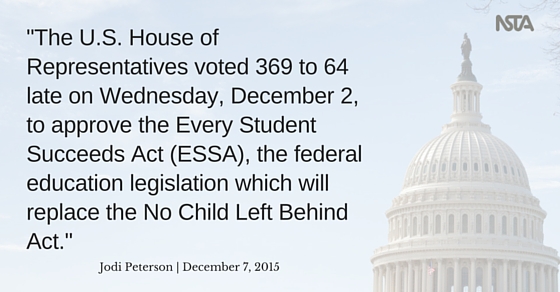House Passes New Education Law, Senate Action Expected Week of Dec. 7
By Jodi Peterson
Posted on 2015-12-07
The U.S. House of Representatives voted 369 to 64 late on Wednesday, December 2, to approve the Every Student Succeeds Act (ESSA), the federal education law which will replace the No Child Left Behind (NCLB) Act. We anticipate the bill will go to the Senate for approval sometime the week of Dec. 7. President Obama is expected to sign the bill into law by year end.
NSTA has endorsed the bill, as noted in this Education Week article.
The bill was also endorsed by most, if not all, of the education and civil rights groups. A big endorsement from the National Governors Association (NGA) and a Wall Street Journal article helped to solidify Republican support in the House. (In their statement the NGA noted that ESSA endorsement “marks the first time that the National Governors Association has endorsed federal legislation since welfare reform in 1996.” The Wall Street Journal noted the bill “isn’t perfect but would represent the largest devolution of federal control to the states in a quarter-century. It’s far better than the status quo that would continue if nothing passes.”)
After the House vote on Dec. 2 Secretary of Education Arne Duncan and the White House praised legislators for passing the bill. In a statement the White House said “The bill rejects the overuse of standardized tests and one-size-fits-all mandates on our schools, ensures that our education system will prepare every child to graduate from high school ready for college and careers, and provides more children access to high-quality state preschool programs.” They called on the Senate to act this week.
Read more about the STEM education provisions in ESSA.
Here are some key highlights in the new bill.
- The new bill eliminates the NCLB highly qualified teacher requirement. States are no longer required by the federal government to do teacher evaluations using student outcomes.
- A $1.6 billion block grant (Title II) consolidates a number of programs, including the Math and Science Partnership program. However there are funding opportunities for STEM teacher professional development, leadership training, grants for performance pay and differential pay, and alternative cert programs throughout the bill in both Title II and Title IV available to both states and districts (more on that here).
- Adequate Yearly Progress AYP is gone. States would test students in reading and math in grades 3 through 8 and once in high school and continue to report on data for the schools and the subgroups of students (such as ELL students, special education students, low income, and minorities). Science testing would continue in the bill, once in elementary grades, once in middle level, and once at high school (similar to current law)
- States would decide what to hold schools and districts accountable for and how to intervene in low performing schools. They must use test scores in accountability frameworks, but also must include multiple measures. States are required to identify and intervene in schools with the bottom 5 percent of performers and intervene in high schools where the graduation rate is 67 percent or less.
- States must adopt “challenging” academic standards. The bill restricts the powers of the Secretary of Education and specifically prohibits the U.S. Secretary of Education from incentivizing, forcing, or coercing states into adopting Common Core, or interfering with a state’s right to develop or change its own set of standards and assessments.
- States to create their own testing opt-out laws but it must maintain the 95 percent student participation federal requirement.
Read the bill here.
Read the Education Week article on the bill here.
There will be more to come on the new federal education law in weeks ahead as we take a deep dive into the 1000-plus-page bill.
Jodi Peterson is Assistant Executive Director of Legislative Affairs for the National Science Teachers Association (NSTA) and Chair of the STEM Education Coalition. e-mail Jodi at jpeterson@nsta.org; follow her on Twitter at @stemedadvocate.
The mission of NSTA is to promote excellence and innovation in science teaching and learning for all.
Follow NSTA
Disclaimer: The views expressed in this blog post are those of the author(s) and do not necessarily reflect the official position of the National Science Teaching Association (NSTA).



